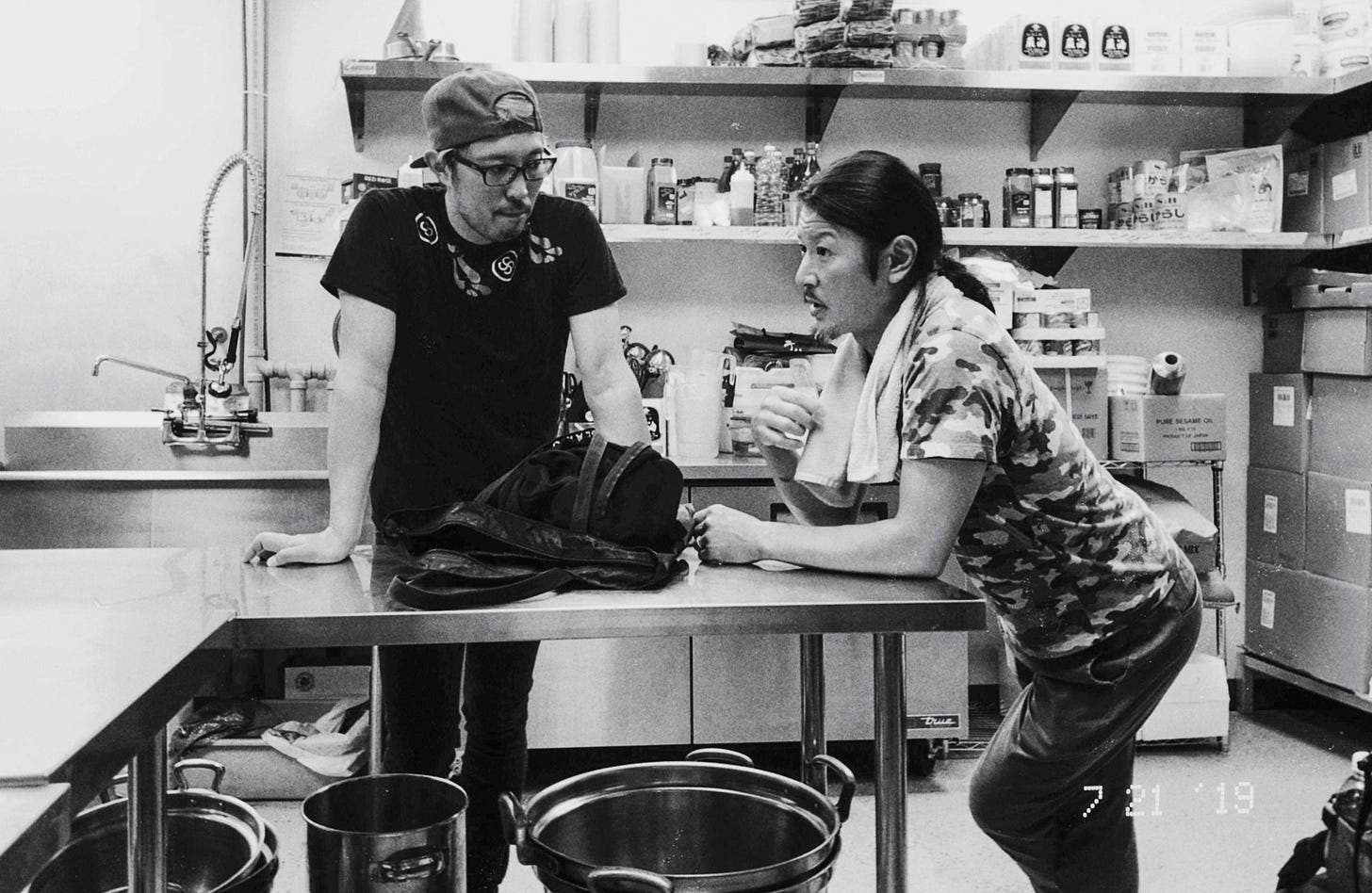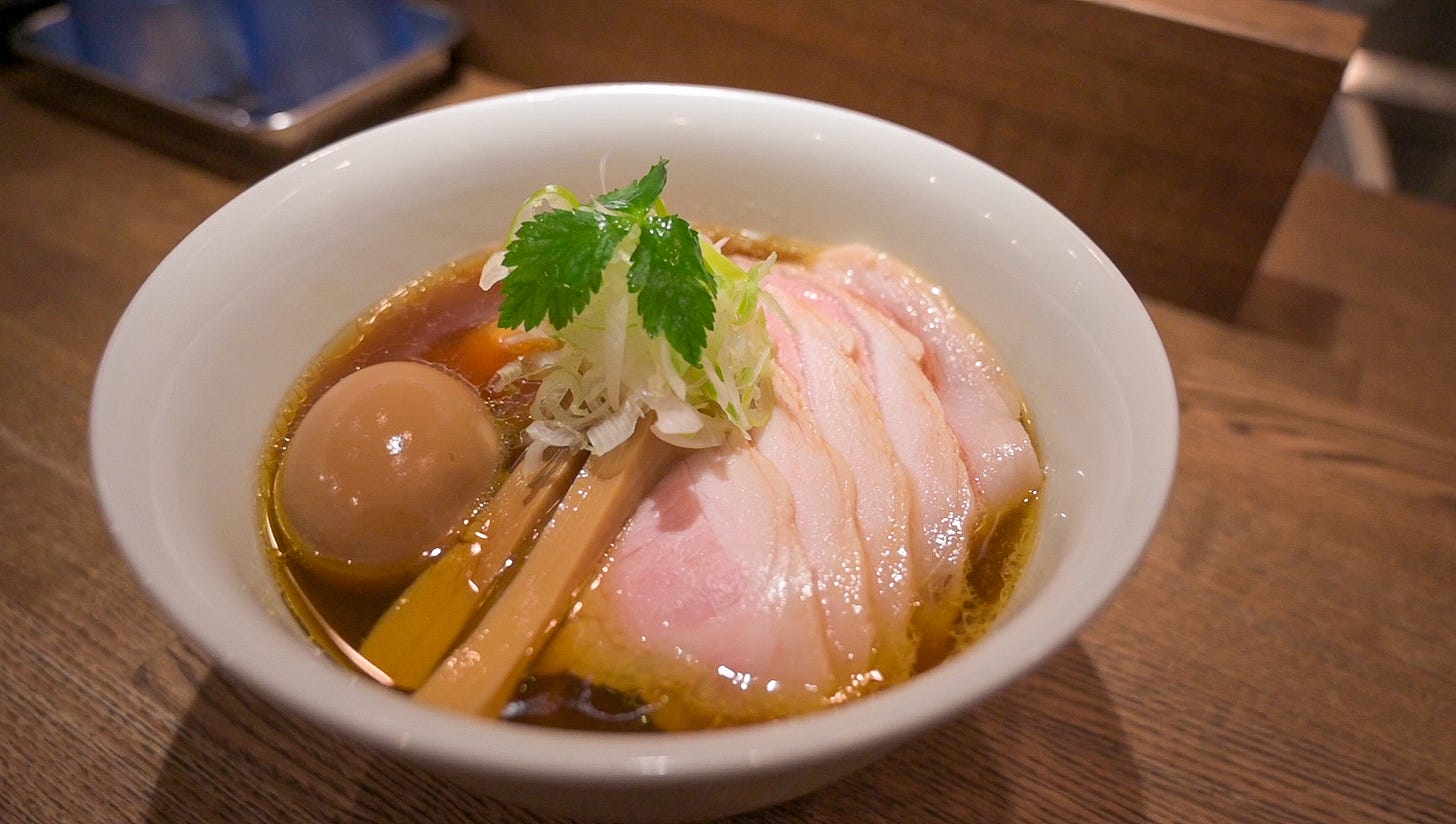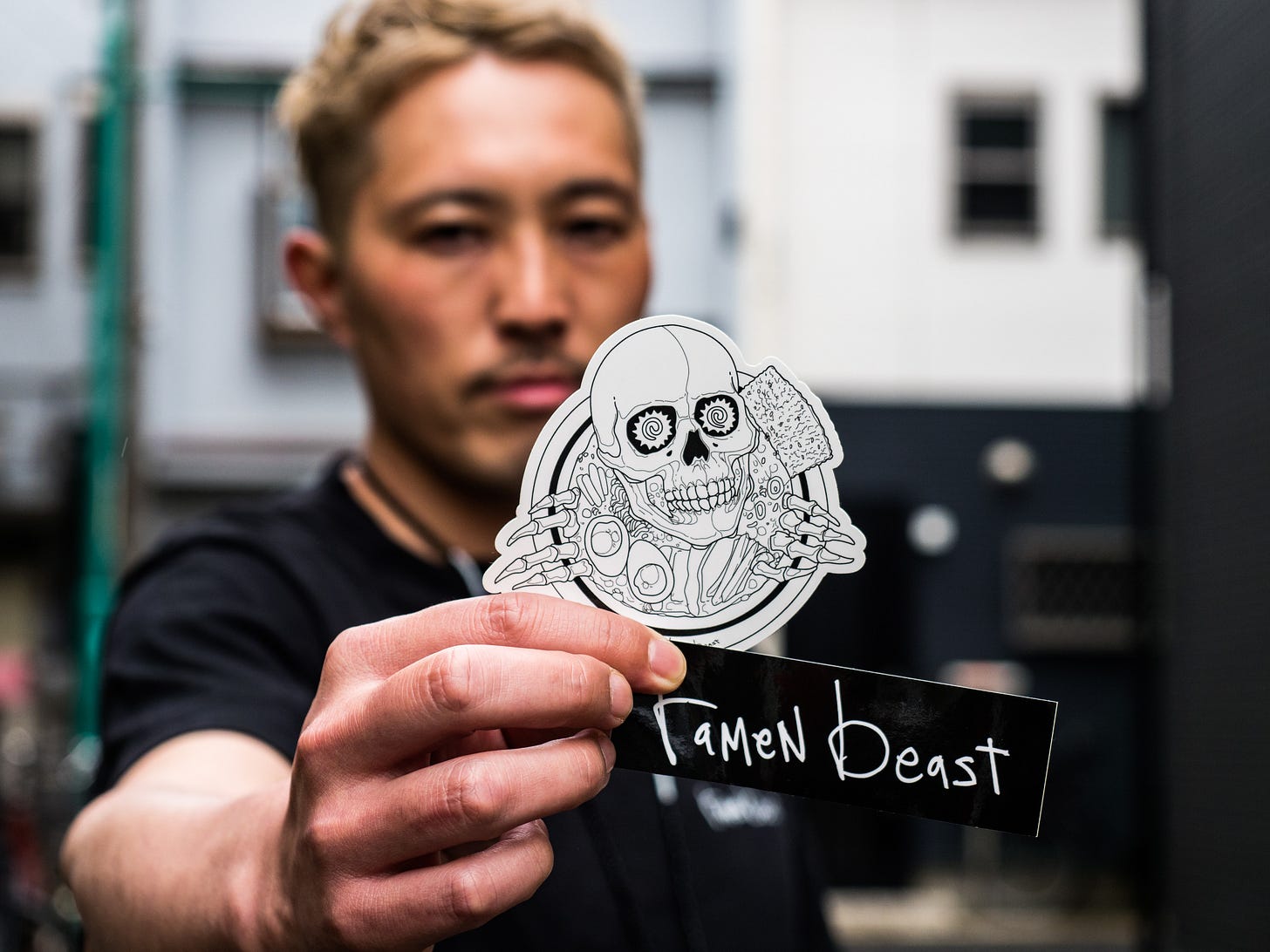Hometown Ramen Hero: A Video Visit to Menpeki Kunen
This week Ramen Beast takes you inside a hidden gem in northwest Tokyo, plus an introduction to the Japanese partner who keeps us plugged in by drinking heavily with famous chefs.
This week, Ramen Beast takes you on a video tour to Menpeki Kunen, an obscure example of everything that we’re into celebrating: A humble shop run by a self-taught shokunin who pours all of his energy and inspiration into creating beautifully balanced ramen for the neighborhood where he grew up.
At Menpeki Kunen in Tokyo’s Iogi district, chef Ishioka Fumishita specializes in two distinct styles of ramen: an "Iriko Soba" made with a soup using seven different types of niboshi (traditional dried fish), and a shoyu ramen prepared from premium Japanese chicken and duck. In the Iriko Soba, a deep amber shoyu blends with the niboshi’s crisp umami punch (the central soup element is dried aji, or Japanese jack mackerel), while a piping hot layer of chicken oil adds some decadence. Toppings include thick-cut menma, an orange-yolked ajitama and a generous fan of blow-torched pork chashu — plus some diced negi and a sprig of mitsuba.
It’s everything that’s great about the current wave of what Ramen Beast has taken to calling neo-Tokyo ramen: meticulously sourced traditional ingredients, haute technique adapted to a fast kitchen, and a finished dish that totally wows you while remaining light and healthful. Amazing ramen, but everyday ramen.
How good can we possibly make noodles and soup, while also keeping it below $10/bowl and still making a modest living? That’s the question that seems to be forever echoing through the scene that Ishioka-san and his ilk inhabit.
What’s especially impressive is that Menpeki is far from a famous shop. Iogi is a random, quiet neighborhood and there are literally hundreds of suburban areas just like it hidden amidst Tokyo’s endless sprawl. Launched last March, Menpeki attracted some notice from the city’s ramen mags as one of the many promising shop debuts of 2020. But despite his relative obscurity, Ishioka-san toils with relentless dedication, his food is impeccably high quality and he draws a steady line of Iogi locals every day for lunch — such is the miraculously high bar of Japan’s food culture. The Ramen Beast team recently paid Ishioka-san a visit to shine a light on the fine work he’s doing out there in Iogi every day.
If you’re new here, this is the Ramen Beast Newsletter — stories and explorations of Japan’s vast ramen subculture. Subscribe, share or email us with your ramen queries.
►The beast behind the scenes
This week, we’d also like to introduce a behind-the-scenes figure at Ramen Beast — Hiroshi Shimakage, our fact checker and tireless ramen world connector. Abram eats more ramen than any of us, but Hiroshi helps keep us legitimate. When we need some detailed info about where a chef trained or some rare ingredient used by some far-flung shop, Hiroshi either already knows or he finds out. When we want to interview or grab drinks with a rising-star chef (such as Ishioka-san above), Hiroshi makes the introduction. Longstanding relationships are everything in Japan, and Hiroshi has them all over the Tokyo ramen scene. In an impressively short period of time, he’s gone from a casual ramen fan to a hardcore head to cooking alongside one of the just two Japanese ramen chefs to hold a Michelin star, Atsushi Yamamoto of Soba House Konjiki Hototogisu.
So here’s our good friend Hiroshi, sharing some of his story.
How has your relationship with ramen culture evolved over the years?
Ramen was a regular part of life for me when I was growing up. My hometown is Kitakata in Fukushima Prefecture, which happens to be a place known for ramen, especially morning ramen (Asa-raa). So when I was growing up, ramen was just a part of daily life. One of my uncles even runs a typical Kitakata-style ramen shop. But when I was 18 years old and I came to Tokyo for university, ramen suddenly became expensive in my eyes. At that time, in the mid-90's, in Kitakata, a bowl of ramen cost around 550 yen (about $5), and in Tokyo a bowl was at least 750 yen ($6.50). Furthermore, regular ramen in Tokyo would usually come topped with one slice of pork chashu, whereas in Kitakata standard ramen normally comes topped with four or five slices. And if you order chashumen — ramen with extra pork chashu on top — in Tokyo, it would usually be served with three or four slices, whereas in Kitakata the bowl is completely covered in delicious chashu. So after I came to Tokyo, I sort of stopped eating ramen regularly — basically for almost 10 years. It just seemed like a bit of a ripoff compared to the countryside ramen I was used to. A lot of us in Japan have these hometown loyalties. But when I met Abram, he ignited my interest in ramen again.
Can you share that story?
I met Abram at a little yakitori spot in Hatagaya, where we were both regulars. Every time I would bump into him there, he would talk to me about ramen. At that time, I would think, why does this foreign guy have so much passion for ramen? I was very curious. I had never met someone so passionate about ramen, and he wasn't even Japanese. One day, he recommended a ramen shop located near Shinjuku station. So I went there, and I was like fuck, this is amazing! Ramen evolved a lot during the 90s and early 2000s and I had never really properly explored Tokyo ramen. So I then decided I needed to eat ramen more. Abram and I also became close friends, and we hunted ramen relentlessly together.
How did you go from being a ramen fan to being part of the Tokyo ramen world inner circle?
At the same time I was getting into Tokyo ramen, I was also lucky enough to build a good relationship with another regular customer at the same yakitori spot, a guy who was a food writer for Playboy magazine (which in Japan is a weekly city lifestyle magazine). I wanted to introduce Abram to him, thinking maybe we could do something interesting together. That is basically the story of how he and Abram ended up collaborating on the weekly Playboy article 'Ramen Americajin,' where this writer followed Abram's adventures in the Japanese ramen world, writing about his unique perspective on the scene.
Also, around this time, the same guy started offering me part-time work finding ramen shops for him. I would find shops that were offering seasonal and gentei (limited edition) bowls, and contact the masters of those shops to set up photoshoots for Playboy magazine. So because of this, I slowly began to get more into the ramen scene, and develop relationships with some leading ramen masters. And as I started to become closer to ramen masters and started to see what went on behind the scenes, I began to realize that this is something I wanted to share with the world- working with my international friends and exploring whatever ramen opportunities might come my way.

And then eventually you started working alongside Yamamoto-san.
The first time I went to Hotogisu I was just a customer. Actually, at that time I was young and a bit cocky — I had just started getting into the scene. So that first day I went to Hototogisu, I was with a friend, and I guess I was talking aloud about all the different masters I had made connections with. Yamamoto-san was cooking right in front of us and could, of course, hear our conversation, but he didn't say a word. Years later, he told me that after that first day he didn't like me. Anyway, a few months later, I was back at Hototogisu again and I politely introduced myself to his wife, who was doing customer service there at the time. She got Yamamoto-san and I presented my business card and said I'd like to build a relationship in case there was an opportunity to feature him in Playboy. His ramen was already extremely good, and I was there mostly to pay respects at that time. He gave me his business card as well, but nothing came of it. However, a few months later, I happened to get invited to a nomikai (drinking party) with a bunch of ramen masters. When I arrived, Yamamoto-san was there in the group. That night we talked a little, drank a lot, and I guess he warmed up to me a bit.
Fast forward a few years to around 2017, Yamamoto-san and I had become quite friendly. By this time I was living in Hatagaya, about a five minute walk from Hototogisu (this was back at its legendary original location, before the shop moved to Shinjuku), so I would eat there regularly — at least a few times a month. Sometimes we would bump into each other at ramen master nomikai too. Around this time, I was thinking about quitting my job. I was working installing high-speed internet systems at construction sites, mostly high-end office buildings. I'd say it was a little more interesting than being an average salaryman, only because I was lucky enough to get the chance to occasionally travel around Japan for work, trying different regional styles of ramen during these trips. But in 2016, there was an announcement within the company that business was not great, and all employees' salaries would be slightly reduced moving forward. After I got this news, I went to Hototogisu to eat and have a beer and I happened to mention to Yamamoto-san that I was thinking about quitting my job. It was then that he told me he was going to open a ramen shop in Toronto, and asked if I was interested in helping him as an interpreter and assistant. I told him, sure. He also said he was going to have a seven-day pop-up shop serving ramen in Niigata Prefecture, and he asked me to help him. To be honest I knew nothing about cooking; I had worked part-time at an izakaya in college, but this was another ballgame. Yamamoto-san was already one of the big stars of the Tokyo ramen scene. I would have to start from zero. But I figured I would need to learn more about ramen from the chef's side if I were going to have to translate for him in Canada. So that became the first time we worked together in the kitchen.
What's that ramen chef community like? Are there rivalries or is it mostly friendly?
The scene is pretty interesting. All of these guys love ramen to the core. Of course, some are rivals and competitive, but generally everyone just wants to make the ramen scene bigger together, and they all want to expand ramen culture. In a way, they all want the bar to be raised collectively. There's a huge amount of passion. So even though there are rivalries, for the most part, everyone is still friendly and helps each other out. There are lots of interesting collaborations and team-ups, ramen events, and some huge drinking parties.
What are the drinking parties like?
Well, during New Year in Japan there are generally many bōnenkai (end of year parties) and shinnenkai (beginning of year parties), so especially during these times many masters meet up and get hammered together. Sometimes you'll have 10-15 of Tokyo's top ramen masters just hanging out, sharing stories, and getting smashed together. Usually at izakayas, usually until morning, usually with something crazy eventually happening. Buy me a drink and I'll tell you those stories. [Laughs] I shouldn't break the code in print though.
What do you like about being part of this community and what do you see as your role in it?
Of course, I love to eat ramen, but I feel I need to learn more about what's going on behind the counter, so that I can understand the masters more. As far as my role? Nothing really! Even within the community of ramen masters, I don't really think they consider me to have a role. I'm just a friend. But sometimes I help different masters do pop-ups or open restaurants overseas. And sometimes I help connect them with the international foodie world.
You know a lot of high-level ramen chefs. What do these guys tend to have in common?
One thing they all have in common is passion. They all have so much passion for what they do, and they never stop improving their craft. And they're all super serious and strict when actually making ramen, regardless of how friendly they are in real life. They have these two sides.
What have you learned from working with Yamamoto-san.
These days I'm primarily helping him as his interpreter, and also sometimes helping him with kitchen operations overseas. I've learned the basics of preparing ramen from him. When I work with him in the kitchen, he does all the prep and I tend to assemble the bowls as the orders come in. We work in complete silence — I understand him and I think he trusts me to an extent now. The main thing I've learned from him is probably just how crazy tough it is to make ramen at his level. He is always thinking about ingredients. Even after he got a Michelin star, he hasn’t changed. He's always learning and always trying to improve his technique. He is never satisfied. He's an intense guy and a total pro. He has a tough exterior, but in the right circumstances he's super fun.
What’s interesting for you about being part of a group like Ramen Beast, which speaks to the English-language food world outside Japan?
For me, it's perfect because it matches my unique path in the ramen world. I grew up in a Japanese town famous for ramen, but then later got totally hooked on ramen because of an American guy's infectious passion for it. What I really want to do is help share authentic ramen culture. Ramen in some form is popular almost everywhere now, but so many people in the world haven't had the chance to experience real ramen — so I think we can help introduce not just real bowls of ramen, but what goes on behind the scenes and where this culture comes from. I'd like to help keep it authentic.
What do you think people from overseas tend to misunderstand most about ramen?
In order to enjoy its maximum deliciousness, ramen is a food that needs to be eaten quickly. It's okay to take some photos, but you should do so as quickly as possible, for just a few moments. You shouldn't be chatting casually or going to take a bathroom break midway through your bowl. You should be focused, slurping, and enjoying the meditative experience. The noodles get soft quickly. The bowl loses all of its magical qualities after just a few minutes. And it should be piping hot. There's no time for messing around.
This is something I notice at ramen restaurants overseas — people hanging out and talking with their friends, eating at a leisurely pace, like they would with any other kind of casual, sit-down restaurant. If the food you're eating in that restaurant is still good when you eat it that way, I'd say it's probably not real ramen.
I'm sure people don't realize it, but when they take this slow, casual approach in Japan, they're kind of confusing and disrespecting the chef. The shop master has put tremendous effort into preparing this special dish for you, and there's an unspoken understanding that you will give the bowl your full attention and eat it the way that was intended. If you do that at the right shop, you're almost guaranteed to have an amazing experience.
Hiroshi is currently assisting Yamamoto-san during his stint at the Ramen Walker Kitchen in Tokorozawa, Saitama. Launched in November 2020 by Ramen Walker magazine, which is one of Tokyo’s most popular ramen culture publications, the Ramen Walker Kitchen hosts a different celebrated chef each month for a four-week residency. During their stay, the chefs create a special menu for the die-hard fans who make the pilgrimage to Tokorozawa. Chefs featured so far have included Madai Ramen Mengyo of Kinshicho, Chuka Soba Yotsuba of Chiba and Menya Shichisai from near Tokyo station.
During April, Yamamoto-san is the chef of honor. During business hours, Ramen Walker provides a live kitchen feed via their YouTube channel. Tune in to catch Hiroshi and Yamamoto-san at work.
- Edited by Patrick Brzeski, produced collectively by the Ramen Beast team.








I own two ramen shops in the US and out of all the ramen I had in Tokyo Menpeki Kunen was my favorite. That said there are a lot of these modern Shoyu shops that are excellent